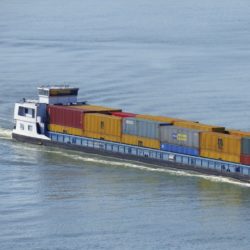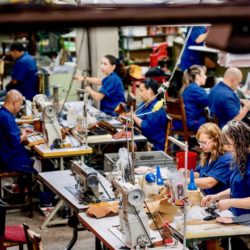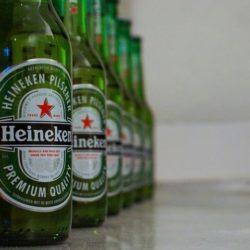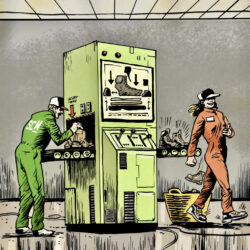Sustainability legislation creates huge new task for GS1
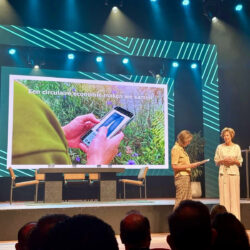
Under ESG legislation, companies have to start recording a long list of sustainability data. In this context, standardization organization GS1 has an important task to fulfil. Moreover, by introducing a new QR code, as the successor to the barcode, companies can improve sustainable use among customers and promote circularity. “Sustainability requires a journey through the entire chain and we are going to facilitate that for them,” said CEO Mirjam Karmiggelt at the GS1 congress in Hilversum.
By Harm Beerens
GS1 is a global organization that, among other things, issues the barcodes used in shops and supermarkets. It also develops the standards and databases in which manufacturers and retailers share product data. For years it was mainly about commercial and logistical product characteristics, but something very important has been added here, stated Karmiggelt (pictured, right) during her opening talk. “Sustainability and circularity have greatly fuelled the demand for data, and we have an important role to play in that,” said the CEO of GS1 Netherlands.
During the conference, speakers from several Dutch companies explained how they are using GS1 services to achieve their sustainability goals. “Together with GS1, we have created a digital passport for all our products,” said Jeanet van der Stoel of workwear supplier Groenendijk Bedrijfskleding. “In it, customers can see the origin of a product, but also how they can use the product as sustainably as possible and how it can be taken back for recycling at the end of its life cycle.”
Very time-consuming
For many companies, collecting sustainability data is a job they cannot possibly do themselves. “We have a database of more than three million different procurement items,” explained Marc de Dobbelaere of Zevij-Necomij, a procurement organization for technical wholesalers. “To request all that additional information for so many products and assess suppliers on sustainability is very time-consuming. We chose to link with an external platform that collects this information for us.”
Collecting data is one thing, but you also have to present it to your clients in the right way, according to Susan van Kruijsbergen of Koninklijke Paardekooper Group. The packaging materials wholesaler supplies 65,000 clients in 75 countries. “They all have their own way of working and different information needs. The big retailers work with GS1, but we also supply to production companies, fruit growers and local bakers. Many of them still just work with Excel.”
Proliferation of quality marks
What further complicates sustainability-related data management is the proliferation of quality marks and certificates, all of which place different requirements on the data. “In our sector alone, there are about 50 quality marks,” stated Richard Schouten of the GroentenFruit Huis. He was referring to labels such as Fairtrade, EKO, Demeter, EU Organic and many, many more. “If you have to cough up data for every quality mark, at some point it is no longer manageable.”
Miriam Geelhoed of Modint, a trade association for the fashion industry, concurred. “It is already so complex to obtain the necessary data from suppliers in Bangladesh, for example, and to verify whether it is actually correct. For that, you need unambiguous standards that everyone in the world understands.” Together with a number of other parties, Modint therefore set up the GS1 Fashion Base, which includes a fixed set of sustainability characteristics.
New QR code
As a company, you are not only responsible for the footprint upstream in the supply chain, but you are also held accountable for what happens to your product further downstream. One thing that will help in this context is the new QR code developed by GS1, which will replace the time-honoured EAN barcode in shops and supermarkets from 2027. The handy thing about this QR code is that, apart from the product code, it can also contain links to websites for sustainability information and to databases for product information.
For Dutch high-street retailer Hema, the new QR code offers great opportunities, according to Manager Category Support Ingmar Hensbergen. “To become the most sustainable retailer in the Netherlands, we started a major programme to reduce our carbon footprint. 94% of that footprint is caused in Scope 3, i.e. outside our company. For some of our products, such as kettles, the biggest impact is in the post-sales phase, i.e. during consumer use. The new QR code provides a tool to guide the customer in this.”
Heineken Experience
“We see GS1’s QR code as a tool to connect consumers and our products,” commented Pieter Timmermans of Heineken. “At the moment, our products often contain a barcode to scan in shops and a QR code that links to a brand website, for example. With the new QR code, we have everything in one. Apart from a link to the digital product passport, we are also considering doing something with the Heineken Experience. We don’t yet know what that will look like, but we see a lot of possibilities.”
And so a new phase has begun for GS1. CEO Mirjam Karmiggelt: “We started standardizing product data and labels 20 years ago. In the coming years, we will do the same with sustainability and circularity.”



